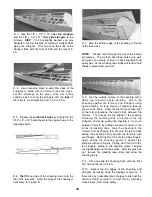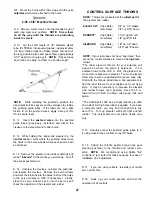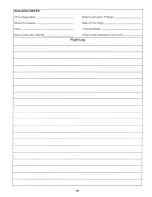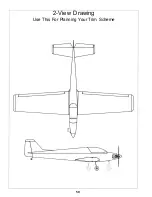
gluing strips of lead into the engine compartment
under the engine Tail weight may be added by using
"stick-on" lead weights*, and, later, if the balance
proves to be OK you can open the fuse bottom and
glue these in permanently If you are using one of the
larger capacity receiver battery packs, as
recommended, you can change the balance
significantly by relocating that pack For instance, if
you are using the SuperTigre 2500 engine, you may
need to mount the battery pack behind the servos.
*Before applying stick-on weights to MonoKote,
prepare the MonoKote as f o l l o w s Clean the
MonoKote thoroughly with alcohol, poke several
pinholes in the area where the weights are to be
located; apply a drop of thin CA to each pinhole, and
wipe off any excess CA with a quick swipe of a tissue
This technique bonds the MonoKote more securely to
the balsa, preventing the weights from pulling the
MonoKote away from the structure.
FINAL HOOKUPS AND CHECKS
1. Make sure the control surfaces move in the proper
direction as illustrated in the following sketches:
Radio Set-Up
Four Channel Aircraft
Transmitter
Stick Movement
Control Surface
Movement
Elevator Moves Up
Right Aileron Moves
UP and Left Aileron
Moves DOWN
Rudder moves LEFT
Carburetor Wide Open
2. Adjust your pushrod hookups as necessary to
provide the proper control surface movements as
listed on Page 47
3. Check for wing twist as follows:
NOTE: Even if you have built your wing on a perfectly
flat surface and used utmost care, it is possible that
your wing may have a twist due to uneven shrinking of
the covering material You must check for this
condition and correct it before the first flight.
If you do not own a wing incidence meter, we
recommend that you purchase one from your local
hobby dealer or borrow one from another modeler.
With the wing mounted to the fuselage, use the
incidence meter to check the angle of your wing at the
root and at the tips If the incidence meter reveals a
wing twist of more than 1/4 degree, you must grasp
the wing at the tip and twist it slightly, while reheating
the covering material Keep checking, twisting and
reheating until the wing twist is removed NOTE: If
you have corrected a wing twist by this method, you
should periodically re-check to make sure the
correction has held.
PRE-FLIGHT
CHARGE THE BATTERIES
Follow the battery charging procedures in your radio
instruction manual. You should always charge your
transmitter and receiver batteries the night before you
go flying, and at other times as recommended by the
radio manufacturer.
FIND A SAFE PLACE TO FLY
1. The best place to fly your R/C model is an AMA
(Academy of Model Aeronautics) chartered club field.
Ask your hobby shop dealer if there is such a club in
your area and Join Club fields are set up for R/C
flying which makes your outing safer and more
enjoyable The AMA can also tell you the name of a
club in your area We recommend that you Join AMA
and a local club so you can have a safe place to fly
and also have insurance to cover you in case of a
flying accident (The AMA address is listed near the
front of this instruction book).
If a club and its flying site are not available,
you need to find a large, grassy area at least 6 miles
away from any other R/C radio operation like R/C
boats and R/C cars and away from houses, buildings
and streets A schoolyard may look inviting but it is
too close to people, power lines and possible radio
interference.
GROUND CHECK THE MODEL
If you are not thoroughly familiar with the operation of
R/C models, ask an experienced modeler to check to
see that you have the radio installed correctly and that
51
Содержание Ultra-Sport 1000
Страница 7: ...7 DIE PATTERNS Use This Drawing To Identify Die Cut Parts...
Страница 57: ...57...
Страница 59: ...2 View Drawing Use This For Planning Your Trim Scheme 59...









































